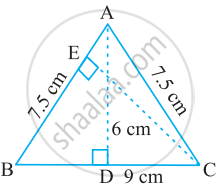Advertisements
Advertisements
Question
If the points A(−2, 1), B(a, b) and C(4, −1) are collinear and a − b = 1, find the values of a and b.
Solution
The given points are A (−2, 1), B (a, b) and C (4, −1).
Since the given points are collinear, the area of the triangle ABC is 0.
`=>1/2[x_1(y_2-y_3)+x_2(y_3-y_1)+x_3(y_1-y_2)]=0`
Here, `x_1=-2, y_1=1, x_2=a, y_2=b and x_3=4, y_3=-1`
`therefore 1/2[-2(b+1)+a(-1-1)+4(1-b)]=0`
-2b-2-2a+4-4b=0
2a+6b=2
a+3b=1 ........(1)
Given :
a-b=1 ..............(2)
Subtracting equation (1) from (2), we get:
4b=0
b=0
Substituting b = 0 in (2), we get:
a=1
Thus, the values of a and b are 1 and 0, respectively.
APPEARS IN
RELATED QUESTIONS
In each of the following find the value of 'k', for which the points are collinear.
(7, -2), (5, 1), (3, -k)
Find the area of a triangle with vertices at the point given in the following:
(1, 0), (6, 0), (4, 3)
ΔABC is isosceles with AB = AC = 7.5 cm and BC = 9 cm (see the given figure). The height AD from A to BC, is 6 cm. Find the area of ΔABC. What will be the height from C to AB i.e., CE?

Find the area of a triangle whose vertices are
(a, c + a), (a, c) and (−a, c − a)
Prove analytically that the line segment joining the middle points of two sides of a triangle is equal to half of the third side.
Find a relation between x and y, if the points A(x, y), B(-5, 7) and C(-4, 5) are collinear.
The area of a triangle with vertices (a, b + c), (b, c + a) and (c, a + b) is ______.
If the points A(1, 2), O(0, 0) and C(a, b) are collinear, then ______.
Find the area of the triangle whose vertices are (–8, 4), (–6, 6) and (–3, 9).
Triangles having the same base have equal area.
